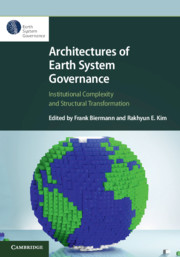Book contents
- Architectures of Earth System Governance
- Series page
- Architectures of Earth System Governance
- Copyright page
- Contents
- Contributors
- Acknowledgements
- 1 Architectures of Earth System Governance
- Part I The Building Blocks
- Part II Core Structural Features
- Part III Policy Responses
- 9 Policy Integration
- 10 Interplay Management
- 11 Orchestration
- 12 Governance through Global Goals
- 13 Hierarchization
- Part IV Future Directions
- Glossary
- Index
- References
13 - Hierarchization
from Part III - Policy Responses
Published online by Cambridge University Press: 17 April 2020
- Architectures of Earth System Governance
- Series page
- Architectures of Earth System Governance
- Copyright page
- Contents
- Contributors
- Acknowledgements
- 1 Architectures of Earth System Governance
- Part I The Building Blocks
- Part II Core Structural Features
- Part III Policy Responses
- 9 Policy Integration
- 10 Interplay Management
- 11 Orchestration
- 12 Governance through Global Goals
- 13 Hierarchization
- Part IV Future Directions
- Glossary
- Index
- References
Summary
Hierarchization is a deliberate process to create a vertically nested governance architecture where actors and institutions in a lower rank are bound or otherwise compelled to obey, respond to or contribute to higher-order norms and objectives. Drawing on this definition, we review recent research on hierarchization in earth system governance and the political and legal processes that establish, maintain and legitimize it. Here we present three mutually non-exclusive forms of hierarchization – systematization, centralization and prioritization. Each involves different actors and rationales, mechanisms and strategies, while achieving different purposes with varying governance outcomes. We illustrate our argument with empirical examples including the proposed Global Pact for the Environment, the proposal to establish a world environment organization and the Sustainable Development Goals. We conclude with an assessment of the benefits and drawbacks of hierarchization as an approach to some of the challenges inherent in earth system governance, and offer suggestions for future research.
Keywords
Information
- Type
- Chapter
- Information
- Architectures of Earth System GovernanceInstitutional Complexity and Structural Transformation, pp. 275 - 296Publisher: Cambridge University PressPrint publication year: 2020
References
Accessibility standard: Unknown
Why this information is here
This section outlines the accessibility features of this content - including support for screen readers, full keyboard navigation and high-contrast display options. This may not be relevant for you.Accessibility Information
- 8
- Cited by
